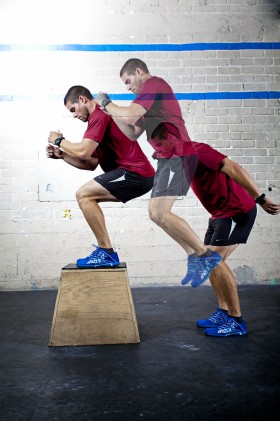 The word “plyometric” is a combination of greek words “pilo” meaning “more” and metric meaning “measure.” Plyometrics are characterized by quick powerful movements that utilizes stretch shortening cycle. Stretch shortening cycle is a fancy way of explaining the action of when a muscle stretches and contracts. Think back to a time in which you had to jump or throw an object; the motion that you used to “load” your arm or hips before you completed an explosive movement. That is the stretch shortening cycle that defines most plyometrics movements.
The word “plyometric” is a combination of greek words “pilo” meaning “more” and metric meaning “measure.” Plyometrics are characterized by quick powerful movements that utilizes stretch shortening cycle. Stretch shortening cycle is a fancy way of explaining the action of when a muscle stretches and contracts. Think back to a time in which you had to jump or throw an object; the motion that you used to “load” your arm or hips before you completed an explosive movement. That is the stretch shortening cycle that defines most plyometrics movements.
Why are plyometrics an important component of exercise routine?
Plyometrics may be the missing key to a fully complete training regimen. You may be wondering "how?"; the answer is actually quite simple. Just as you perform strengthening exercises and provide external stress to your body and your muscles adapt, your bones work in a very similar manner. Then how do you work the bones so they become stronger and adapt to external stimuli? (Do you see where this is going?) The answer is plyometrics! High impact exercise or activity provide adequate external stimulus to the skeletal system to elicit a response with added bone formation. In a day and age in which bone injuries in sports and osteoporosis are reaching very high levels, bone health should be considered across the board: athletes and general population.
Plyometrics are a very beneficial additive to most everyone’s workout regimen-when done correctly that is. In this day and age when circuit training, and pushing yourself to the limits day in and day out, plyometrics are not meant to be used in this manner. In the following weeks I will continue my blog series on the steps needed to safely implement plyometrics for your added benefit in the long run. The steps and process that I will outline is very much similar to that of how I take college athletes through learning progressions. It’s easy to train hard, but hard to train smart. In the coming weeks I will outline how to smartly incorporate plyometrics into your training regimen, whether you are an athlete or consider yourself part of the general population. Stay tuned for next week where I will outline how to properly land and the basics needed for beginner plyometrics. Until then, Happy Lifting!
References
- Baechle, T.R. & Earle, R.W. (2008). Essentials of Strength Training and Conditioning (3rd ed.). Champaign: Human Kinetics.
- Bone Health. (2013, February 16). Retrieved February 14, 2016, from www.comebackmomma.com website:http://www.comebackmomma.com/bone-health/
- Improve Your Explosiveness: How To Do A Box Jump. (2014, June 24). Retrieved February 14, 2016, from www.running.competitor.com website: http://running.competitor.com/2014/06/training/improve-your-explosiveness-how-to-do-a-box-jump_42440
Very informative read! I have seen where your progressions work well and can't wait to hear more on programming plyometrics into a workout.
ReplyDelete